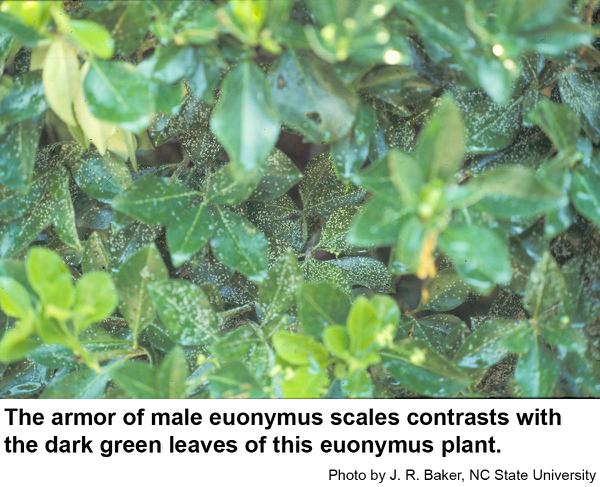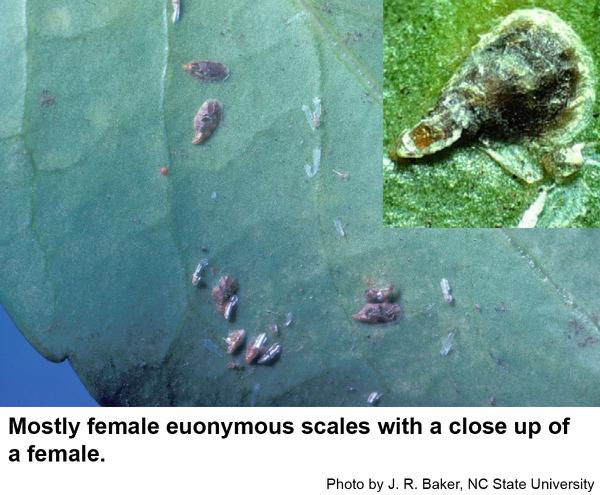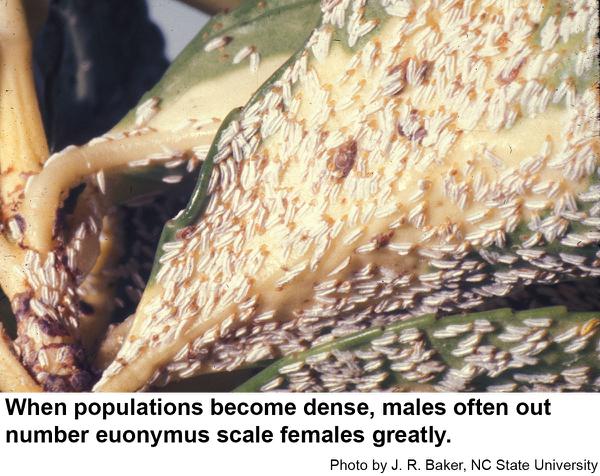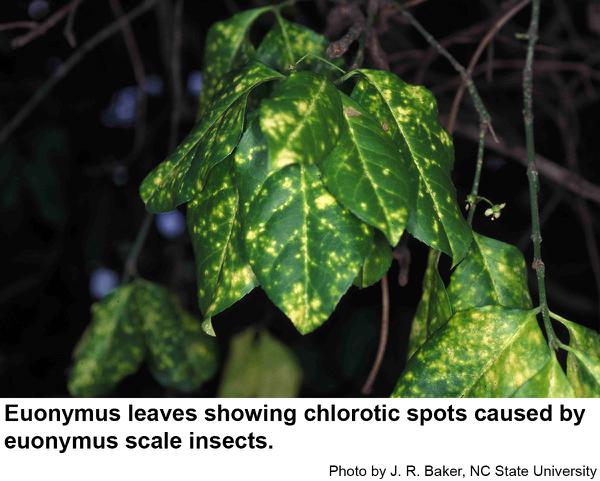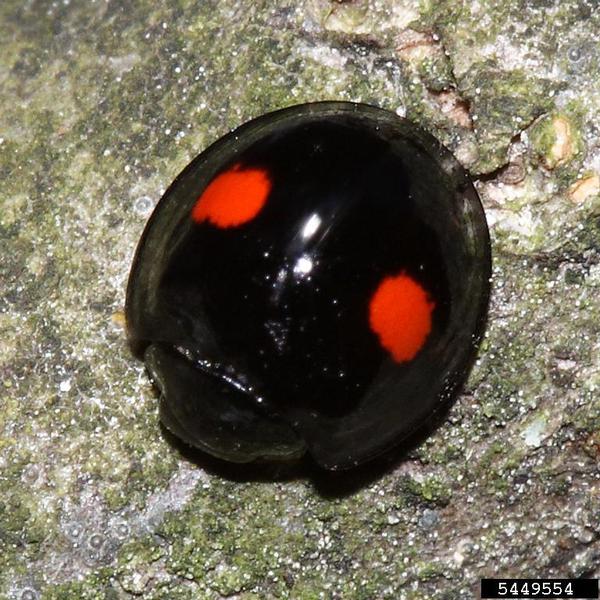Description
The Euonymus scale females, Unaspis euonymi, secrete dark, oyster-shaped armor about 1⁄16-inch long. The armor of male nymphs is narrow, 1⁄32-inch long, and white. Mature males are tiny two-winged insects that emerge from their armor to mate with the females (Females do not leave the protective covering). Eggs are tiny, yellow, oval and are only found beneath the mother's armor. Young crawlers are yellow and very small before they secrete the protective scale covering (armor). Males are usually more numerous than females, and with dense infestations, clusters of the white male armor on the leaves and twigs is noticeable from a distance.
Biology
Euonymus scale is found throughout North Carolina wherever its host plants grow. Euonymus scale is the most commonly reported insect pest of euonymus, pachysandra and celastrus in North Carolina. Female scale feed by inserting microscopic, thread-like mouth parts into the plant and sucking out fluids. This scale usually has two or three generations per year. The males emerge and mate with the females. The females lay eggs under their protective shell, and the tiny crawlers hatch and emerge from the mother's shell in April, May and June. They crawl along the leaves and stems before inserting their mouthparts.
Another brood hatches in late summer, and a partial third brood may appear even later so that all stages of development are present during most of the year. Although this scale is small, infestations are often dense and plainly visible particularly with heavy populations where males usually greatly outnumber female scales.
Host Plants
Euonymus scale is found throughout North Carolina wherever euonymus, pachysandra, and staff vine (staff tree or bittersweet) grow. Yellow spots first appear on the leaves. Leaves and stems may become encrusted with the scales to such an extent that whole branches or the entire plant may die.
Management
Residential Recommendations
Euonymus scale is relatively easy to detect because they cause yellow blotches visible on tops of leaves. However, scale covers do not disappear when the insect dies. To see if the scales are alive, flip over female covers. A live female is an orange blob that releases juice when squashed. If no live scales are present, no treatment is necessary. The armor of dead scales eventually weathers away.
Timing is critical when trying to manage euonymus scale when spraying with insecticides other than horticultural oils. The hard waxy cover protects adult scales from contact insecticides. Therefore, adults treated with a contact insecticide live to produce another generation later on. Crawlers are easily killed because they are small and unprotected by armor. Thus, nearly all products specifically target this stage. Monitor to determine when crawlers are present.
Crawlers emerge from under adult female covers and move about the plant in April or May. At this point the whole population is vulnerable because the crawlers are exposed and all the adults from last year have died.
Euonymus scale has two to three generations per year. Therefore, if you miss the spring emergence and crawlers are not present you have another opportunity later in the summer. Euonymus scale crawlers emerge about every 60 days.
Scales are often treated with broad spectrum insecticides such as pyrethroids or organophosphates that must contact scale to kill them and also kills beneficial insects. Horticultural oil is effective at killing crawlers on contact and has low impact on beneficial insects. Therefore, coverage is important with these products.
Do not spray the tender new growth of euonymus to avoid any phytotoxic effects. Spray before bud break or wait until the new growth has hardened-off somewhat. Water the plant well before spraying or spray after adequate rainfall. If the shrub is under moisture stress, the pesticide (especially oils) may damage the foliage.
Commercial Recommendations
Some newer products are available that offer systemic activity for longer control and are softer on beneficial insects (Table 1). Systemic or translaminar activity allows the product to be absorbed into plant tissue. Others can be applied as a drench to be taken up by the roots. Thus, it reduces the need for thorough coverage on difficult to spray plant parts such as the underside of leaves.
Another intervention option is removing problem plants. Plants that are severely damaged from years of scale infestation or that require yearly treatment to keep scale free may not be worth the work. Consider replacing with a newer Euonymus variety that is more resistant to scale or with another plant altogether. Research has found Euonymus fortunei to be less susceptible to scale infestations than E. japonicas and E. kiatschovicus species. In addition, variegated Euonymus varieties increase scale reproduction and survival more than green varieties. The lady beetle, Chilocorus kuwanae, has been shown to be highly effective in controlling euonymus scale, but it difficult to find commercially and has been hard to locate in natural settings in North Carolina.
| Active Ingredient | Trade Name | Scale Stages Affected | Labeled Location | Activity | Signal Word | IRAC MOA Group | Compatible with Beneficials |
|---|---|---|---|---|---|---|---|
| acetamiprid | TriStar | Crawler, adult | G, N, L | Translaminar Systemic | Caution | 4A | Yes |
| dinotefuran | Safari | Crawler, adult | G, N, L, I | Systemic | Caution | 4A | Yes |
| horticultural oil* | Many | Crawler | G, N, L, I | Contact | Warning | - | Yes |
| insecticidal soap* | Many | Crawler | G, N, L, I | Contact | Warning | - | Yes |
| pyriproxyfen | Distance | Crawler | G, N, L, I | Translaminar Systemic | Caution | 7C | Yes |
| G = greenhouse, N = nursery, L = landscape, I = interiorscape * Suitable for homeowner use. |
|||||||
Other Resources
- Chilocorus kuwanae, (Coleoptera: Coccinellidae). Sadof, C. 1995. Biological Control. Cornell Univ. College Agr. and Life Sciences.
- Euonymus Scale. Hoover, G. A., Sr. 2003 (revised). Insect Advice from Extension, PennState College of Agricultural Sciences, Department of Entomology.
- Euonymus Scale. Pellitteri, P. 2012. University of Wisconsin Insect Diagnostic Lab.
- NC State Extension Plant Pathology Publications
- NC State Horticultural Science Publications
- North Carolina Agricultural Chemicals Manual
For assistance with a specific problem, contact your local Cooperative Extension center.
Publication date: April 1, 2009
Reviewed/Revised: Sept. 18, 2019
N.C. Cooperative Extension prohibits discrimination and harassment regardless of age, color, disability, family and marital status, gender identity, national origin, political beliefs, race, religion, sex (including pregnancy), sexual orientation and veteran status.

